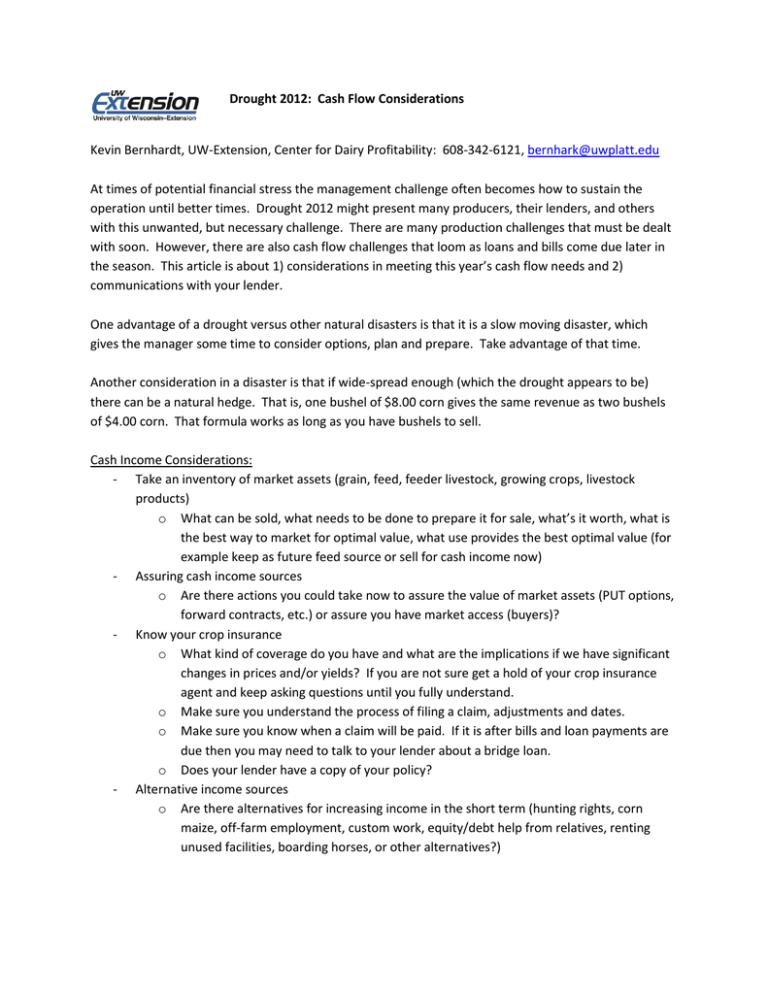Drought 2012: Cash Flow Considerations ,
advertisement

Drought 2012: Cash Flow Considerations Kevin Bernhardt, UW-Extension, Center for Dairy Profitability: 608-342-6121, bernhark@uwplatt.edu At times of potential financial stress the management challenge often becomes how to sustain the operation until better times. Drought 2012 might present many producers, their lenders, and others with this unwanted, but necessary challenge. There are many production challenges that must be dealt with soon. However, there are also cash flow challenges that loom as loans and bills come due later in the season. This article is about 1) considerations in meeting this year’s cash flow needs and 2) communications with your lender. One advantage of a drought versus other natural disasters is that it is a slow moving disaster, which gives the manager some time to consider options, plan and prepare. Take advantage of that time. Another consideration in a disaster is that if wide-spread enough (which the drought appears to be) there can be a natural hedge. That is, one bushel of $8.00 corn gives the same revenue as two bushels of $4.00 corn. That formula works as long as you have bushels to sell. Cash Income Considerations: - Take an inventory of market assets (grain, feed, feeder livestock, growing crops, livestock products) o What can be sold, what needs to be done to prepare it for sale, what’s it worth, what is the best way to market for optimal value, what use provides the best optimal value (for example keep as future feed source or sell for cash income now) - Assuring cash income sources o Are there actions you could take now to assure the value of market assets (PUT options, forward contracts, etc.) or assure you have market access (buyers)? - Know your crop insurance o What kind of coverage do you have and what are the implications if we have significant changes in prices and/or yields? If you are not sure get a hold of your crop insurance agent and keep asking questions until you fully understand. o Make sure you understand the process of filing a claim, adjustments and dates. o Make sure you know when a claim will be paid. If it is after bills and loan payments are due then you may need to talk to your lender about a bridge loan. o Does your lender have a copy of your policy? - Alternative income sources o Are there alternatives for increasing income in the short term (hunting rights, corn maize, off-farm employment, custom work, equity/debt help from relatives, renting unused facilities, boarding horses, or other alternatives?) - - Take an inventory of capital assets o Capital assets are those that you use to create future income (equipment, land, and breeding stock). Normally you do not want to sell capital assets to cover cash flow as you are also losing potential for future earnings. However, an inventory may help identify capital assets that if sold will have minimal impacts on future operations and doing so early will allow for disposal in ways other than at a low fire sale price. Selling capital assets should be considered with extreme caution. Take into consideration any tax implications Cash Expense Considerations - Cash Operating Expenses o What expenses have to be made this year, how much, and when are they due? o Are their opportunities to extend due dates for all or at least partial amounts? - Capital Expenditures o What planned capital expenditures can wait o For expenditures that are a must, can the amount of cash outlay be reduced (this of course results in a larger future expense) o Are there less expensive substitutes (smaller/older tractor or custom hire) - Other cash expenses o Can family living or other non-farm expenses be trimmed? Communicating with your lender and other service providers Cardinal Rule: Lenders do not like surprises! Talk to your lender early and often. Your lender can best help you if you are well prepared. Prepare your cash flow and “what if” questions ahead of time, make use of available human resources to help in your preparation including alternatives to evaluate (county Extension agent, consultants, accountant, etc.), and consider a range of drought scenarios including extreme drought scenarios. At what prices and yields does your cash flow fall to a critical level that cannot be covered without disrupting planned operations? That is, at what level will an unplanned conversion of equity or increase in debt financing be needed to cover cash flow? The situation could call for adjusting the operation in greater ways. For example selling older breeding livestock and keeping younger stock may be a way to generate cash today and reduce the need for finding feed in the year ahead. However, remember that any changes, big or small, will likely change future cash flow needs, profitability, repayment capacity and may create different financing needs in the future than was originally planned. Again, talk to your lender early and often. Finally, this is an emotional time, which makes it even more important to make decisions based on reason and fact. For more drought information consult your UW-Extension County office or see the UW-Extension Drought 2012 website at http://fyi.uwex.edu/drought2012/.

